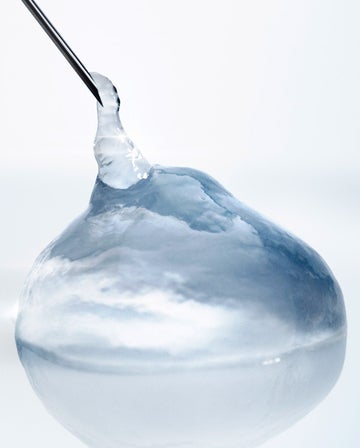Why all this fuss about hyaluronic acid?
As many beauty enthusiasts already know, hyaluronic acid is found in many tissues in the body, such as the skin, joints, and eyes. It’s a strongly water-binding molecule that has even been called “nature’s own moisturizer” because of its hydrating and lubricating effect on body tissues.2,3
These aspects have made hyaluronic acid a popular ingredient to use in both medical and cosmetic products.2
A challenge with using natural hyaluronic acid though is that it forms and degrades in a couple of days.4 To make it last longer, manufacturers of HA fillers use different technologies to cross-link the hyaluronic acid molecules to each other. The cross-linking leads to the formation of more stable molecules that are still close to natural hyaluronic acid but may last for several months.4
Why are there so many different HA fillers?
The manufacturers use several technologies to create their gels, and they also strive to develop HA fillers with different properties. Larger brands usually have several filler varieties in their product portfolios.
Among the huge number of HA fillers on the market, some have been created to have a firmer consistency whereas others are softer and more flexible.1 This means healthcare practitioners have different gels to choose from, depending on the effect they want to create.
Here’s where things become a bit more intricate. There are many opinions about how HA gels behave in the skin once injected. What aspects are the most important ones?
How can you determine the properties of different HA fillers?
Putting HA fillers to the test
A few years ago, scientists at Galderma (owner of the Restylane® brand) took a closer look at filler gels from four different brands, Restylane® and three competitor brands, to find out how they behaved in human skin.
The skin in this study was donated by a woman who had undergone surgery to remove excess abdominal skin, so all gels were tested on the same skin.1
Filler integration in the skin
The scientists used microphotographs to establish to which extent the different gels integrated into the skin.1 They found out, and this may sound fairly intuitive, that firmer gels had a higher ability to withstand mechanical forces and spread less in the tissue, whereas softer gels spread and integrated to a higher degree.1
Other gel factors such as particle size, cohesivity, or swelling factor did not affect integration.1
Filler variety
Among the brands tested, Restylane® had both the firmest and the softest HA fillers. Restylane’s breadth is made possible by to two different gel technologies – NASHA™, that produces firmer gels, and OBT™, that produces softer gels (OBT™ is called XpresHAn™ in the United States).1,5
What are the benefits of filler integration?
Still, many people might wonder why anyone would want a gel that integrates more in the tissue. Isn’t it better if it stays exactly where it’s injected?
The answer is – it depends on the desired effect. Some of us may be anxious to maintain a natural-looking appearance after an aesthetic treatment. When softer gels are injected they integrate more in the tissue and the flexibility of the gel means it can adapt to movements when you make facial expressions.6 To make sure it really works as intended, scientists examined how flexible HA fillers behave in the face.
Can you maintain natural expressions after treatment with HA fillers?
Analysis of two OBT gels
A few years ago, another group of scientists affiliated with Galderma decided to test two softer Restylane filler gels to find out if they could be used to treat wrinkles while keeping the treated persons’ natural expressions.
The gels used in the study, Restylane® Defyne™ and Restylane® Refyne™, are both based on the OBT technology. A difference between them is that Restylane Defyne has a higher degree of cross-linking, resulting in greater gel firmness. This type of gel provides structural support, while still being flexible, and can be suitable to treat more severe wrinkles.6
Treating wrinkles in the lower face while keeping a natural look
The scientists used video recordings and photos as well as standardized and accepted measurement scales to compare the result one month after the treatment with what the participants looked like before.6
60 women and 3 men between 35 and 65 years participated in the study.6 A criterium for being enrolled was to have moderate to severe nasolabial folds (the wrinkles from the nostrils down to the corners of the mouth) and at least one more wrinkle in the lower part of the face suitable for treatment.6
The participants were asked to make a number of facial expressions, such as big smile, blowing out a candle, pursed kiss, and they were also recorded while reading a standard text.6
The result: Yes it worked!
Firstly, a standardized 5-grade “wrinkle severity scale” was used to measure if there were any improvements to the wrinkles. That’s the whole point of treating wrinkles with HA fillers – to reduce them!
Secondly, the naturalness of expressions was measured by comparing photos and videos before and one month after the treatment.
According to the investigators, as many as 97% of participants had their wrinkles reduced by at least 1 grade. Similarly, 97% of the participants assessed themselves as aesthetically improved.6
The naturalness of expressions was also maintained in 95% of participants.6
So, to sum up, the OBT gels work well to reduce wrinkles as well as create results that look natural, also when the face is in motion.
Documentation of side effects
In all scientific studies, side effects are carefully documented. The most common side effects in this study included bruising, tenderness, and swelling that took, at the most, 14 days to disappear. Six events were rated adverse events but were mild and resolved spontaneously without any intervention.6
What HA fillers are based on the OBT technology?
If you’re interested in being treated with OBT gels, it could be good to know that there are five of them:
- Restylane® Defyne™
- Restylane® Refyne™
- Restylane® Volyme™
- Restylane® Kysse™
Make sure to always consult qualified healthcare practitioners if you are considering an aesthetic treatment of any kind.
References:
- Lundgren, B. et al.; Using a New Photo Scale to Compare Product Integration of Different Hyaluronan-Based Fillers After Injection in Human Ex Vivo Skin, J Drugs Dermatol. 2018 Sep 1;17(9):982-986.;
- Fallacara A. et al, Polymers 2018, 10(7), 701;
- Necas J. et al, Veterinarni Medicina, 53, 2008 (8): 397–411;
- Coleman, S., Cross-Linked Hyaluronic Acid Fillers, Plast Reconstr Surg. 2006 Feb; 117(2):661-5.;
- Edsman, K. et al., Cohesion of Hyaluronic Acid Fillers: Correlation Between Cohesion and Other Physicochemical Properties, Dermatol Surg 2017;0:1–6;
- Philipp-Dormston, W.G. et al.; Evaluating Perceived Naturalness of Facial Expression After Fillers to the Nasolabial Folds and Lower Face With Standardized Video and Photography, Dermatol Surg. 2018 Jun; 44(6): 826–832.






